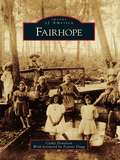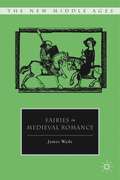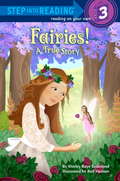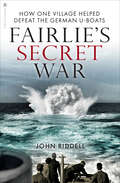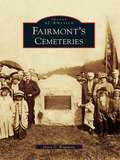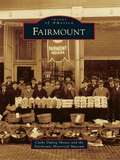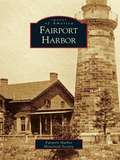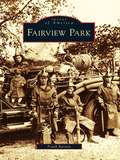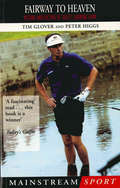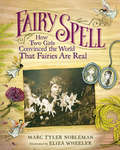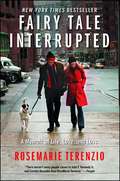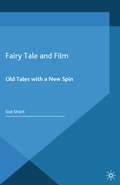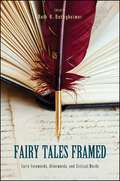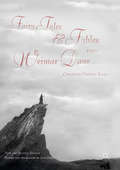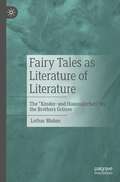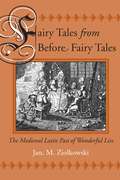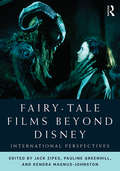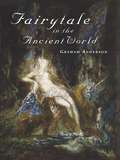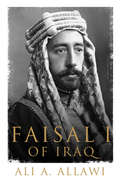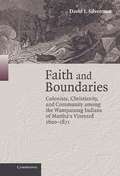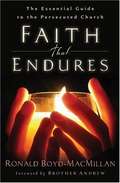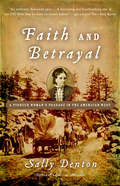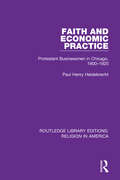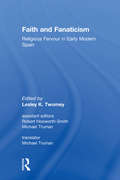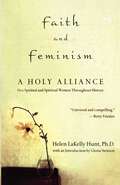- Table View
- List View
Fairhope
by Fannie Flagg Cathy DonelsonThree centuries of Utopian dreams came true in the 1890s, when a group of idealists founded Fairhope as a cooperative colony on a lush bluff along Alabama's Gulf Coast. The visionary settlers thought their experimental village had a "fair hope" of success. An oasis of idealism and equality, Fairhope not only succeeded but grew into an elegant enclave of individualism and intellect. The bayside town is the world's oldest and largest single-tax colony as well as a popular resort that draws visitors from around the world. Photographic images herein capture the uniquedevelopment by adventurous characters with diverse backgrounds. This book is a map of "Old Fairhope."
Fairies in Medieval Romance
by James WadeThis is the first book to construct a theoretical framework that not only introduces a new way of reading romance writing at large, but more specifically that generates useful critical readings of the specific functions of fairies in individual romance texts.
Fairies! A True Story (Step into Reading)
by Shirley Raye Redmond Red HansenFrom the forest fairies of West Africa to the magical brownies of Scotland, people have told stories about fairies for a long, long time. In England, two little girls shocked the world when they claimed that they had proof that fairies existed; they had photographs! But are fairies myth? Or are they magic? Fairy fans and beginning readers will delight in this easy-to-read look at fairy folklore and sightings through the ages.
Fairlie’s Secret War: How One Village Helped Defeat German U-Boats
by John RiddellDuring the Second World War the Royal Navy’s vitally important Anti-submarine Experimental Establishment was secretly moved from Portland in Dorset to the Ayrshire village of Fairlie, to escape German bombing on the south coast. For the next six years it occupied the boatyard of yacht builder William Fife on the Firth of Clyde. During this time, highly confidential world-leading research on the acoustic detection of submarines by asdic – now known as sonar – was carried out by hundreds of scientists, officers and local men and women based at Fairlie. As experiments took place into new ways of sinking German U-boats, the peace of the quiet village was shattered. Winston Churchill described the work done at Fairlie as critical to winning the Battle of the Atlantic and ultimately the war. The research remained relevant to anti-submarine warfare long after the war, and is still relevant today. Fairlie’s role in the war was not disclosed until relatively recently. Highly illustrated throughout and making use of previously unpublished material, this book tells the full story of the establishment at Fairlie for the first time. It describes the impact it had on local people, and their relationship with the naval officers and scientists who came to work there.
Fairmont's Cemeteries
by Gena D. WagamanFounded in 1820 by Boaz Fleming, Fairmont, West Virginia, is located midway between Morgantown and Clarksburg. It is the seat of Marion County, which was formed in 1842 from Harrison and Monongalia Counties. During its heyday in the early 20th century, Fairmont was home to 100 millionaires who prospered in the town largely because of the coal fields, which were connected to the Eastern Seaboardmarkets by the Baltimore and Ohio Railroad. Today Fairmont is undergoing a renaissance and looks forward to continued growth while retaining its unique history.
Fairmount (Images of America)
by Cathy Duling Shouse Fairmount Historical MuseumSettled in 1829 by antislavery Quakers from the south, Fairmount benefited from the many travelers going between Fort Wayne and Indianapolis and became known as a station on the Underground Railroad. From these humble beginnings, a tight-knit community evolved that valued culture, especially education and literature. Decades later, newspaper stories marveled at the Quakers' Fairmount Academy and the number of accomplished individuals affiliated with the area, including writers, scientists, and college presidents. Like several Indiana towns, in 1887 this small, primarily agricultural area participated in one of the most dramatic eras in state history: the natural gas boom. Renowned artist Olive Rush was born and raised in Fairmount. The ancestors of one pioneering Quaker family, the Winslow's, raised film icon James Dean on their Fairmount farm. Garfield cartoonist Jim Davis lived near Fairmount and graduated from Fairmount High School. Their stories and those of their friends and neighbors are captured in these images that represent the best of America's heartland.
Fairport Harbor
by Fairport Harbor Historical SocietySurrounded by water on three sides, Fairport Harbor, Ohio, was once a gateway to the Western Reserve, welcoming more ships to its shores than Cleveland. These ships brought immigrants-Irish, English, and others-who saw the harbor's towering 1825 lighthouse, one of the town's two lighthouses on the National Registry of Historic Sites, as a beacon for freedom, hope, and opportunity. Indeed, the town served a prominent role in the Underground Railroad, helping southern slaves along their way to freedom in Canada. Ship building and Great Lakes shipping became the major industries, and soon homes, warehouses, and businesses began to flourish-Fairport Harbor was booming.Fairport Harbor tells the story of the village's rich history with captivating vintage photographs that capture all the natural beauty of this lakeside community. Featured inside are the historic landmarks-buildings, churches, and of course lighthouses that are so identifiable with the village's past. Also featured are the people-the fishermen, shipbuilders, and railroad workers who all helped build one of the most picturesque harbor towns on all of Lake Erie's shores.
Fairview Park (Images of America)
by Frank BarnettFairview Park is truly a postwar community. Before World War II, it was mainly rural countryside just beginning to see some development. The Rocky River valley had been enough of a barrier to keep Fairview that much more rural until high-level bridges were built in the 1920s. A brochure at the time for the newly developed Coffinberry Estates in northeast Fairview Park refers to "quick access to downtown Cleveland via Hilliard Road, Detroit Avenue, or Lorain Avenue bridges." The bridges residents now take for granted were then a major selling point. The farmland started to evolve into suburbia as spaces between houses were filled with more houses. Fairview Village became Fairview Park in 1948, and the year before, Cuyahoga County's first shopping center was built here.
Fairway to Heaven: Victors and Victims of Golf's Choking Game
by Tim Glover Peter HiggsIn golf, nowhere is the mental strain more apparent that at the closing stages of a major championship. The crowd, absorbed in every shot, conveys the tension to the players, who are also involved in another contest - the mind game. Before missing the most notorious putt in the history of the Open Championship, Doug Sanders was already thinking of which side of the gallery he would turn to first to acknowledge the applause. When he missed a three foot putt that would have won him the old silver claret jug, there was no applause. Instead people reacted as if they had just witnessed a terrible accident - which, in a sporting context they had. It was Jack Nicklaus, rather than Sanders, who went for the jugular and, in the process, took possession of the jug. The line between victor and victim can be measured not only in millions of dollars but also in fractions of inches. `One minute you're on cloud nine, ' Sam Snead remarked
Fairy Spell: How Two Girls Convinced the World That Fairies Are Real
by Marc Tyler Nobleman Eliza WheelerIn 1917, in Cottingley, England, a girl named Elsie took a picture of her younger cousin, Frances. Also in the photo was a group of fairies, fairies that the girls insisted were real. Through a remarkable set of circumstances, that photograph and the ones that followed came to be widely believed as evidence of real fairies. It was not until 1983 that the girls, then late in life, confessed that the Cottingley Fairies were a hoax. <P><P> Their take is an extraordinary slice of history, from a time when anything in a photograph was assumed to be fact and it was possible to trick an eager public into believing something magical. Exquisitely illustrated with art and the original fairy photographs.
Fairy Tale Interrupted: A Memoir of Life, Love, and Loss
by RoseMarie TerenzioWorking Girl meets What Remains in this New York Times bestselling, behind-the-scenes story of an unlikely friendship between America&’s favorite First Son, John F. Kennedy Jr. and his personal assistant, a blue-collar girl from the Bronx. Featured in the documentary I Am JFK Jr.!From the moment RoseMarie Terenzio unleashed her Italian temper on the entitled nuisance commandeering her office in a downtown New York PR firm, an unlikely friendship bloomed between the blue-collar girl from the Bronx and John F. Kennedy Jr. Many books have sought to capture John F. Kennedy Jr.’s life. None has been as intimate or as honest as Fairy Tale Interrupted. Recalling the adventure of working as his executive assistant for five years, RoseMarie portrays the man behind the icon—patient, protective, surprisingly goofy, occasionally thoughtless and self-involved, yet capable of extraordinary generosity and kindness. She reveals how he dealt with dating, politics, and the paparazzi, and describes life behind the scenes at George magazine. Captured here are her memories of Carolyn Bessette, how she orchestrated the ultra-secretive planning of John and Carolyn’s wedding on Cumberland Island—and the heartbreak of their deaths on July 16, 1999, after which RoseMarie’s whole world came crashing down around her. Only now does she feel she can tell her story in a book that stands as “a fitting personal tribute to a unique boss . . . deliriously fun and entertaining” (Kirkus Reviews).
Fairy Tale and Film: Old Tales with a New Spin
by S. ShortSue Short examines how fairy tale tropes have been reworked in contemporary film, identifying familiar themes in a range of genres – including rom coms, crime films and horror – and noting key similarities and differences between the source narratives and their offspring.
Fairy Tales Framed: Early Forewords, Afterwords, and Critical Words
by Ruth B. Bottigheimer2012 CHOICE Outstanding Academic TitleMost early fairy tale authors had a lot to say about what they wrote. Charles Perrault explained his sources and recounted friends' reactions. His niece Marie-Jeanne Lhéritier and her friend Marie-Catherine d'Aulnoy used dedications and commentaries to situate their tales socially and culturally, while the raffish Henriette Julie de Murat accused them all of taking their plots from the Italian writer Giovan Francesco Straparola and admitted to borrowing from the Italians herself. These reflections shed a bright light on both the tales and on their composition, but in every case, they were removed soon after their first publication. Remaining largely unknown, their absence created empty space that later readers filled with their own views about the conditions of production and reception of the tales.What their authors had to say about "Puss in Boots," "Cinderella," "Sleeping Beauty," and "Rapunzel," among many other fairy tales, is collected here for the first time, newly translated and accompanied by rich annotations. Also included are revealing commentaries from the authors' literary contemporaries.As a whole, these forewords, afterwords, and critical words directly address issues that inform the contemporary study of European fairy tales, including traditional folkloristic concerns about fairy tale origins and performance, as well as questions of literary aesthetics and historical context.
Fairy Tales and Fables from Weimar Days
by Jack ZipesThis book is a collection of traditional German fairy tales and fables, deliberately transformed into utopian narratives and social commentary by political activists in the Weimar Republic (1919-1933). Against a backdrop of financial and political instability, widespread homelessness, and the reformation of public institutions, numerous gifted writers such as Berta Lask, Kurt Schwitters, Hermynia zur Mühlen, Oskar Maria Graf, Bruno Schönlank, and Joachim Ringelnatz responded to the need for hope among the common people by creating fairy tales and fables that offered a new and critical vision of social conditions. Though many of their tales deal with the grim situation of common people and their apparent helplessness, they are founded on the principle of hope. This revised edition includes over 50 illustrations by contemporary international artists who reveal how similar the Weimar conditions were to the conditions in which we presently live. In this respect, the Weimar fairy tales and fables have not lost their spirit and significance.
Fairy Tales as Literature of Literature: The "Kinder- und Hausmärchen" by the Brothers Grimm
by Lothar BluhmIn this study, the Brothers Grimm's fairy tales are consistently examined as literature out of literature. Through the history of their creation and transformation, it becomes apparent how literary models were re-declared and transformed into the well-known fairy tale narratives, in the course of the editing process by the Brothers Grimm, essentially by Wilhelm Grimm. By means of a series of model studies – including Rapunzel, Jorinde und Joringel and Der Jude im Dorn – it is shown that the Brothers Grimm's fairy tales, contrary to their traditional assessment as 'folk tales', are of literary origin and have a literary character themselves.
Fairy Tales from Before Fairy Tales: The Medieval Latin Past of Wonderful Lies
by Jan M. ZiolkowskiWhen did fairy tales begin? What qualifies as a fairy tale? Is a true fairy tale oral or literary? Or is a fairy tale determined not by style but by content? To answer these and other questions, Jan M. Ziolkowski not only provides a comprehensive overview of the theoretical debates about fairy tale origins but includes an extensive discussion of the relationship of the fairy tale to both the written and oral sources. Ziolkowski offers interpretations of a sampling of the tales in order to sketch the complex connections that existed in the Middle Ages between oral folktales and their written equivalents, the variety of uses to which the writers applied the stories, and the diverse relationships between the medieval texts and the expressions of the same tales in the "classic" fairy tale collections of the nineteenth century. In so doing, Ziolkowski explores stories that survive in both versions associated with, on the one hand, such standards of the nineteenth-century fairy tale as the Brothers Grimm, Hans Christian Andersen, and Carlo Collodi and, on the other, medieval Latin, demonstrating that the literary fairy tale owes a great debt to the Latin literature of the medieval period. Jan M. Ziolkowski is the Arthur Kingsley Porter Professor of Medieval Latin at Harvard University.
Fairy-Tale Films Beyond Disney: International Perspectives
by Jack Zipes Pauline Greenhill Kendra Magnus-JohnstonThe fairy tale has become one of the dominant cultural forms and genres internationally, thanks in large part to its many manifestations on screen. Yet the history and relevance of the fairy-tale film have largely been neglected. In this follow-up to Jack Zipes’s award-winning book The Enchanted Screen (2011), Fairy-Tale Films Beyond Disney offers the first book-length multinational, multidisciplinary exploration of fairy-tale cinema. Bringing together twenty-three of the world’s top fairy-tale scholars to analyze the enormous scope of these films, Zipes and colleagues Pauline Greenhill and Kendra Magnus-Johnston present perspectives on film from every part of the globe, from Hayao Miyazaki’s Spirited Away, to Jan Švankmajer’s Alice, to the transnational adaptations of 1001 Nights and Hans Christian Andersen. Contributors explore filmic traditions in each area not only from their different cultural backgrounds, but from a range of academic fields, including criminal justice studies, education, film studies, folkloristics, gender studies, and literary studies. Fairy-Tale Films Beyond Disney offers readers an opportunity to explore the intersections, disparities, historical and national contexts of its subject, and to further appreciate what has become an undeniably global phenomenon.
Fairytale in the Ancient World
by Graham AndersonIn this, the first modern study of the ancient fairytale, Graham Anderson asks whether the familiar children's fairytale of today existed in the ancient world. He examines texts from the classical period and finds many stories which resemble those we know today, including:* a Jewish Egyptian Cinderella* a Snow White whose enemy is the goddess Artemis* a Pied Piper at Troy.He puts forward many previously unsuspected candidates as classical variants of the modern fairytale and argues that the degree of violence and cruelty in the ancient tales means they must have been meant for adults.
Faisal I of Iraq
by Dr Ali A. AllawiBorn in 1883, King Faisal I of Iraq was a seminal figure not only in the founding of the state of Iraq but also in the making of the modern Middle East. In all the tumult leading to the dissolution of the Ottoman Empire and the establishment of new Arab states, Faisal was a central player. His life traversed each of the important political, military, and intellectual developments of his times. This comprehensive biography is the first to provide a fully rounded picture of Faisal the man and Faisal the monarch. Ali A. Allawi recounts the dramatic events of his subject's life and provides a reassessment of his crucial role in developments in the pre- and post-World War I Middle East and of his lasting but underappreciated influence in the region even 80 years after his death. A battle-hardened military leader who, with the help of Lawrence of Arabia, organized the Arab Revolt against the Ottoman Empire; a leading representative of the Arab cause, alongside Gertrude Bell, at the Paris Peace Conference of 1919; a founding father and king of the first independent state of Syria; the first king of Iraq-in his many roles Faisal overcame innumerable crises and opposing currents while striving to build the structures of a modern state. This book is the first to afford his contributions to Middle East history the attention they deserve.
Faith And Boundaries: Colonists, Christianity, And Community Among The Wampanoag Indians Of Martha's Vineyard, 1600-1871
by David J. SilvermanIt was indeed possible for Indians and Europeans to live peacefully in early America and for Indians to survive as distinct communities. Faith and Boundaries uses the story of Martha's Vineyard Wampanoags to examine how. On an island marked by centralized English authority, missionary commitment, and an Indian majority, the Wampanoags' adaptation to English culture, especially Christianity, checked violence while safeguarding their land, community, and ironically, even customs. Yet the colonists' exploitation of Indian land and labor exposed the limits of Christian fellowship and thus hardened racial division. The Wampanoags learned about race through this rising bar of civilization - every time they met demands to reform, colonists moved the bar higher until it rested on biological difference. Under the right circumstances, like those on Martha's Vineyard, religion could bridge wide difference between the peoples of early America, but its transcendent power was limited by the divisiveness of race.
Faith That Endures: The Essential Guide to the Persecuted Church
by Ronald Boyd-MacmillanIn many underprivileged countries, the church is under constant persecution. Christians everywhere have heard the stories and seen the newscasts. But there are too many who still don't understand. What does persecution really look like up close? And what can we learn from the faithful endurance persecuted Christians so boldly embody? Ronald Boyd-MacMillan, writer-at-large for Open Doors International, has produced the most compelling and comprehensive look at Christian persecution today. With real life stories, he educates readers on the many levels of church persecution, highlights testimonies that have never before been published, and shows what we all can do to remember, reflect, and respond. Compassionate and provocative, Faith That Endures gives readers a path of connection to their persecuted brothers and sisters in a new and vital way, even as it enlightens and encourages us in our local churches and brings us closer to God.
Faith and Betrayal: A Pioneer Woman's Passage in the American West
by Sally DentonIn the 1850s, Jean Rio, a deeply spiritual widow, was moved by the promises of Mormon missionaries and set out from England for Utah. Traveling across the Atlantic by steamer, up the Mississippi by riverboat, and westward by wagon, Rio kept a detailed diary of her extraordinary journey. In Faith and Betrayal, Sally Denton, an award-winning journalist and Rio's great-great-granddaughter, uses the long-lost diary to re-create Rio's experience. While she marvels at the great natural beauty of Utah, Rio's enthusiasm for her new life turns to disillusionment over Mormon polygamy and violence against nonbelievers, as well as the harshness of frontier life. She sets out for California, where she finds a new religion and the freedom she longed for. Unusually intimate and full of vivid detail, this is an absorbing story of a quintessential American pioneer.
Faith and Economic Practice: Protestant Businessmen in Chicago, 1900-1920
by Paul Henry HeidebrechtFirst published in 1989, Faith and Economic Practice: Protestant Businessmen in Chicago, 1900-1920 ponders the role that religion played in North American society in the 20th Century. Written against the backdrop of a religious resurgence in American society, represented by such phenomena as the Moral Majority, television preachers, prayer breakfasts, parochial schools, brainwashing cults, anti-pornography campaigns and organizations established for the purpose of restoring Judeo-Christian values, the volume examines both the religious milieu and the larger environment in which it functions. Through studying businessmen in Chicago who were both leading actors in a capitalist society and Protestant church members with personal religious agendas, the books explores the interactions between religious expression and economic order and the role of religion in capitalism with the purpose of assessing the extent to which their religious views were shaped by their business experience and social outlook as the wealthy elite of society.
Faith and Fanaticism: Religious Fervour in Early Modern Spain
by Robert Hooworth-SmithThe Spanish Inquisition is often seen as the archetype of religious fervour and fanaticism, and several of the papers here naturally focus on its activities. Overall, however, this volume aims to look at the broader context of religious attitudes in Spain, from the end of the 15th to the late 17th century. In an examination of how the religious orders behaved, the contributors demonstrate that concepts which may now appear excessive were perceived at that time. Similarly, poetry and other literary texts provide evidence for how Jews viewed Christians and Christians viewed Moors.
Faith and Feminism: A Holy Alliance
by Helen LaKelly HuntWhy do so many women of faith have such a strong aversion to feminism? And why do so many feminists have an ardent mistrust of religion? These questions are at the heart of Helen LaKelly Hunt's illuminating look at the alliance between spiritual conviction and social action. Intelligent and heartfelt, Faith and Feminism offers a perceptive look at the lives of five spirited and spiritual women of history, women who combined their undying faith with feminist beliefs and who made the world a better place by doing so. St. Teresa of Ávila, a woman whose bravery in confronting her shadows gave her the strength to connect with the world and live a life of divine action. Lucretia Mott, a Quaker minister, who rose from her quiet upbringing to become a passionate speaker and activist working tirelessly on behalf of justice and peace. Sojourner Truth, a Christian slave, who spoke out with unwavering courage to claim her God-given rightful place as an African American and a woman. Emily Dickinson, an extraordinary poet, who touched the world with her ability to capture and transform the experience of suffering. Dorothy Day, a radical journalist, who lived a life of voluntary poverty as a way of expressing her passion for the Christian faith and care for those in need. A remarkable book that focuses on the idea that spirituality and feminism are really different expressions of the same impulse to make life more whole, Faith and Feminism offers a powerful catalyst for reflecting on our sense of self -- and for living and loving according to our deepest values.
